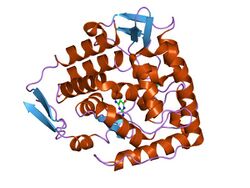Biology:Biopterin-dependent aromatic amino acid hydroxylase
| Biopterin_H | |||||||||
|---|---|---|---|---|---|---|---|---|---|
 crystal structure of ternary complex of the catalytic domain of human phenylalanine hydroxylase (Fe(II)) complexed with tetrahydrobiopterin and norleucine | |||||||||
| Identifiers | |||||||||
| Symbol | Biopterin_H | ||||||||
| Pfam | PF00351 | ||||||||
| InterPro | IPR019774 | ||||||||
| PROSITE | PDOC00316 | ||||||||
| SCOP2 | 1toh / SCOPe / SUPFAM | ||||||||
| CDD | cd00361 | ||||||||
| |||||||||
Biopterin-dependent aromatic amino acid hydroxylases (AAAH) are a family of aromatic amino acid hydroxylase enzymes which includes phenylalanine 4-hydroxylase (EC 1.14.16.1), tyrosine 3-hydroxylase (EC 1.14.16.2), and tryptophan 5-hydroxylase (EC 1.14.16.4). These enzymes primarily hydroxylate the amino acids L-phenylalanine, L-tyrosine, and L-tryptophan, respectively.
The AAAH enzymes are functionally and structurally related proteins which act as rate-limiting catalysts for important metabolic pathways.[1] Each AAAH enzyme contains iron and catalyzes the ring hydroxylation of aromatic amino acids using tetrahydrobiopterin (BH4) as a substrate. The AAAH enzymes are regulated by phosphorylation at serines in their N-termini.
Role in metabolism
In humans, phenylalanine hydroxylase deficiency can cause phenylketonuria, the most common inborn error of amino acid metabolism.[2] Phenylalanine hydroxylase catalyzes the conversion of L-phenylalanine to L-tyrosine. Tyrosine hydroxylase catalyzes the rate-limiting step in catecholamine biosynthesis: the conversion of L-tyrosine to L-DOPA. Similarly, tryptophan hydroxylase catalyzes the rate-limiting step in serotonin biosynthesis: the conversion of L-tryptophan to 5-hydroxy-L-tryptophan. {{Annotated image 4 | caption = {{{caption|In humans, catecholamines and phenethylaminergic trace amines are derived from the amino acid {{nowrap|L-phenylalanine}}.}}} | header_background = #F0F8FF | header = Biosynthetic pathways for catecholamines and trace amines in the human brain<ref name="Trace amine template 1">Broadley KJ (March 2010). "The vascular effects of trace amines and amphetamines". Pharmacol. Ther. 125 (3): 363–375. doi:10.1016/j.pharmthera.2009.11.005. PMID 19948186.</ref>[3][4] | alt = Graphic of catecholamine and trace amine biosynthesis | image = Catecholamine and trace amine biosynthesis.png | image-width = 580 | image-left = 5 | image-top = 0 | align = left | width = 590 | height = 585 | annot-font-size = 14 | annot-text-align = center | annotations =
{{annotation|50|565|{{if pagename|Adrenaline=Adrenaline|Epinephrine=Epinephrine|Catecholamine=Epinephrine|other=Epinephrine}}}}
{{annotation|245|60|{{if pagename|Phenethylamine=Phenethylamine|Trace amine=Phenethylamine|Neurobiological effects of physical exercise={{highlight|Phenethylamine}}|other=Phenethylamine}}}}
{{annotation|245|565|{{if pagename|Norepinephrine=Norepinephrine|Adrenaline=Noradrenaline|Catecholamine=Norepinephrine|other=Norepinephrine}}}}
{{annotation|440|295|p-Octopamine}}}}
pathway
CYP2D6
pathway
Structure
It has been suggested that the AAAH enzymes each contain a conserved C-terminal catalytic (C) domain and an unrelated N-terminal regulatory (R) domain. It is possible that the R protein domains arose from genes that were recruited from different sources to combine with the common gene for the catalytic core. Thus, by combining with the same C domain, the proteins acquired the unique regulatory properties of the separate R domains.
References
- ↑ "Full-length cDNA for rabbit tryptophan hydroxylase: functional domains and evolution of aromatic amino acid hydroxylases". Proc. Natl. Acad. Sci. U.S.A. 84 (16): 5530–4. August 1987. doi:10.1073/pnas.84.16.5530. PMID 3475690. Bibcode: 1987PNAS...84.5530G.
- ↑ "Crystal structure of the catalytic domain of human phenylalanine hydroxylase reveals the structural basis for phenylketonuria". Nat. Struct. Biol. 4 (12): 995–1000. December 1997. doi:10.1038/nsb1297-995. PMID 9406548.
- ↑ "A renaissance in trace amines inspired by a novel GPCR family". Trends Pharmacol. Sci. 26 (5): 274–281. May 2005. doi:10.1016/j.tips.2005.03.007. PMID 15860375.
- ↑ "The endogenous substrates of brain CYP2D". Eur. J. Pharmacol. 724: 211–218. February 2014. doi:10.1016/j.ejphar.2013.12.025. PMID 24374199.
 |

